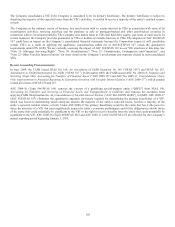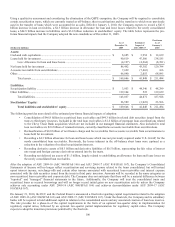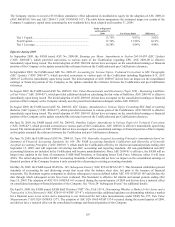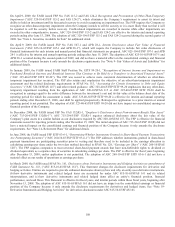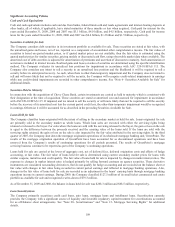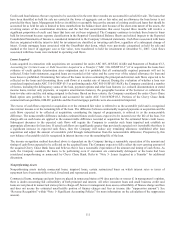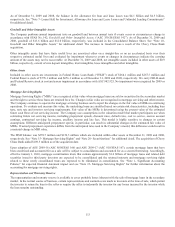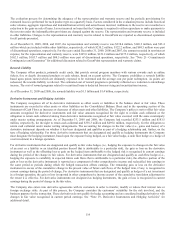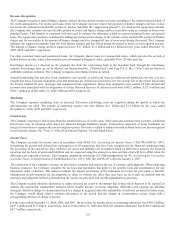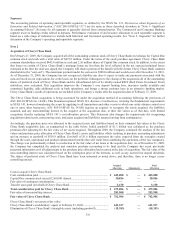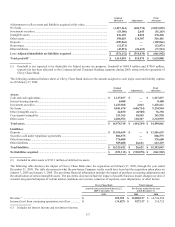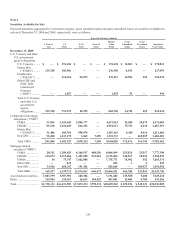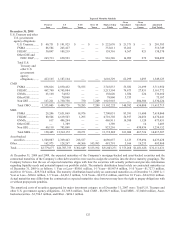Capital One 2009 Annual Report Download - page 128
Download and view the complete annual report
Please find page 128 of the 2009 Capital One annual report below. You can navigate through the pages in the report by either clicking on the pages listed below, or by using the keyword search tool below to find specific information within the annual report. 115
Revenue Recognition
The Company recognizes earned finance charges, interest income and fee income on loans according to the contractual provisions of
the credit arrangements. For credit card loans, when the Company does not expect full payment of finance charges and fees, it does
not accrue the estimated uncollectible portion as income (hereafter the “suppression amount”). To calculate the suppression amount,
the Company first estimates the uncollectible portion of credit card finance charge and fee receivables using an estimate of future non-
principal losses. This formula is consistent with that used to estimate the allowance related to expected principal losses on reported
loans. The suppression amount is calculated by adding any current period change in the estimate of the uncollectible portion of finance
charge and fee receivables to the amount of finance charges and fees charged-off (net of recoveries) during the period. The Company
subtracts the suppression amount from the total finance charges and fees billed during the period to arrive at total reported revenue.
The amount of finance charge and fees suppressed were $2.1 billion, $1.9 billion and $1.1 billion for the years ended December 31,
2009, 2008, and 2007, respectively.
For other consumer loans and commercial loans, the Company places loans in a non-accrual status, which prevents the accrual of
further interest income, when a loan reaches a pre-determined delinquency status, generally 90 to 120 days past due.
Interchange income is a discount on the payment due from the card-issuing bank to the merchant bank through the interchange
network. Interchange rates are set by MasterCard International Inc. (“MasterCard”) and Visa U.S.A. Inc. (“Visa”) and are based on
cardholder purchase volumes. The Company recognizes interchange income as earned.
Annual membership fees and direct loan origination costs specific to credit card loans are deferred and amortized over one year on a
straight-line basis. Fees and origination costs and premiums are deferred and amortized over the average life of the related loans using
the interest method for auto, mortgage and commercial loan originations. Direct loan origination costs consist of both internal and
external costs associated with the origination of a loan. Deferred fees (net of deferred costs) were $148.2 million, $323.9 million and
$389.7 million as of December 31, 2009, 2008 and 2007, respectively.
Marketing
The Company expenses marketing costs as incurred. Television advertising costs are expensed during the period in which the
advertisements are aired. The amount of marketing expense was $0.6 billion, $1.1 billion and $1.3 billion for the years ended
December 31, 2009, 2008 and 2007, respectively.
Fraud Losses
The Company experiences fraud losses from the unauthorized use of credit cards, debit cards and customer bank accounts. Additional
fraud losses may be incurred when loans are obtained through fraudulent means. Transactions suspected of being fraudulent are
charged to non-interest expense after an investigation period. Recoveries related to balances treated as fraud losses are also recognized
in non-interest expense. See “Note 17- Other Non-Interest Expense” for total fraud losses.
Income Taxes
The Company accounts for income taxes in accordance with SFAS 109, Accounting for Income Taxes (“ASC740-10/SFAS 109”),
recognizing the current and deferred tax consequences of all transactions that have been recognized in the financial statements using
the provisions of the enacted tax laws. Deferred tax assets and liabilities are determined based on differences between the financial
reporting and tax basis of assets and liabilities and are measured using the enacted tax rates and laws that will be in effect when the
differences are expected to reverse. The Company adopted the provisions of FASB Interpretation No. 48, Accounting for Uncertainty
in Income Taxes, an Interpretation of FASB Statement No. 109, (“ASC740-10/FIN 48”) effective January 1, 2007.
The calculation of the Company’s income tax provision is complex and requires the use of estimates and judgments. When analyzing
business strategies, the Company considers the tax laws and regulations that apply to the specific facts and circumstances for any
transaction under evaluation. This analysis includes the amount and timing of the realization of income tax provisions or benefits.
Management closely monitors tax developments in order to evaluate the effect they may have on its overall tax position and the
estimates and judgments utilized in determining the income tax provision and records adjustments as necessary.
The Company records valuation allowances to reduce deferred tax assets to the amount that is more likely than not to be realized. In
making this assessment, management analyzes future taxable income, reversing temporary differences and ongoing tax planning
strategies. Should a change in circumstances lead to a change in judgment about the realizability of deferred tax assets in future years,
the Company would adjust related valuation allowances in the period that the change in circumstances occurs, along with a
corresponding increase or charge to income.
For the years ended December 31, 2009, 2008, and 2007, the provision for income taxes on continuing operations was $349.5 million,
$497.1 million and $1.3 billion, respectively, and as of December 31, 2009 and 2008, the valuation allowance was $108.5 million and
$67.7 million, respectively.


